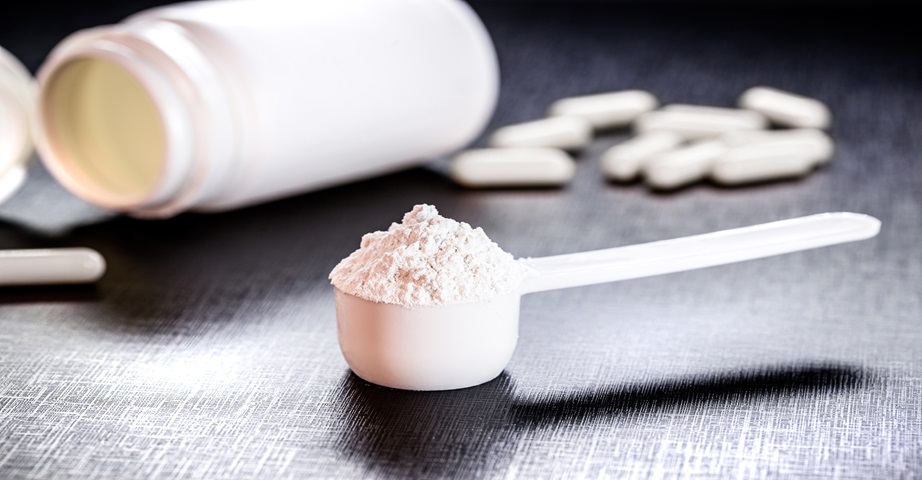Creatine malate - properties, effects, side effects

Creatine malate is the best soluble form of creatine, which due to its excellent absorption in the body enjoys great interest among physically active people. It is a form of a compound that can positively affect the growth of muscle mass, and can also promote the increase of strength and endurance of the athlete. Creatine malate - what does it give? How to use creatine with malic acid? Does creatine malate contribute to the occurrence of undesirable side effects?
Summary
What is creatine?
Creatine, also called beta-methylguanidinoacetic acid, is a chemical compound that can be naturally produced in the human body with the help of amino acids such as L-glycine, L-arginine and L-methionine. It is a substance stored mainly in skeletal muscles, which can also be delivered to the body with daily food - the creatine can be found in animal products such as meat, fish, milk or dairy products.
Due to the fact that the amounts of the creatine naturally synthesized in the body and delivered to the body along with the menu may not be enough to meet the increased demand of athletes, physically active people also often use dietary supplements, which are a concentrated source of the desired substance.
Creatine malate - what is it?
On the market can be found many creatine preparations that differ among themselves, among others, the type of the creatine used. One of the forms of the compound, which is popular among competitors and at the same time is a stable form of the creatine, is creatine malate.
The creatine malate is a form of the compound that is the most soluble form of the creatine. It is a complex, bioavailable structure with excellent absorbability and assimilability, which is created as a result of combining the creatine with malic acid using an ester bond. The creatine malate is a substance safe for the digestive system, which additionally causes less water retention than creatine monohydrate.
recommended dietary supplements with creatine malate
Creatine malate - what does it give? Creatine malate - effects
The creatine malate is formed by combining the creatine with malic acid. The malic acid used in the substance participates in the Krebs cycle, which is one of the most important energy reactions of the human body. The combination of the compound with the creatine positively affects the efficiency of the process and allows the formation of more energy in the form of ATP.
The substance may have an anabolic effect, increasing the synthesis of muscle proteins and positively affecting the size and density of fibres responsible for building muscle. Thus, the creatine malate can contribute to the growth of muscle mass, which can be a particularly desirable phenomenon among athletes focusing on strength disciplines. What's more, the compound can promote the increase of strength and endurance of the athlete and may delay the appearance of fatigue, which may influence into the ability to perform longer and more effective workouts. There are also studies suggesting that creatine supplementation may increase the body's tolerance to perform intense exercise in high temperatures and heat.
The creatine malate can positively affect the regenerative processes occurring in the body. The component may limit the formation of excessive amounts of lactic acid in the muscles, and thus may reduce the risk of soreness and delayed muscle pain (DOMS). Moreover, the compound can accelerate the repair of micro-injuries caused during intense physical exercise and can reduce the time of the body's return to full condition. Thus, the creatine malate can allow you to get ready to take another workout faster.
The results of scientific research suggest that the creatine malate can be helpful not only among athletes and physically active people. The conducted analyses inform that creatine supplementation may have a beneficial effect on the elderly, causing an increase in non-fat body mass, as well as increasing strength and resistance to fatigue. What is more, seniors who use creatine preparations and at the same time practice resistance training can observe an improvement in the performance of daily activities and an increase in bone mineral density, as well as an improvement in neuropsychological performance.
Creatine malate - how to use?
Popular among athletes are two methods of using creatine preparations - also those that contain the creatine malate.
Until recently, the most commonly used way of creatine malate supplementation was the use of "charging phase", that is, taking significant amounts of the compound for several days, divided into smaller portions during the day, and then including in supplementation "the maintenance phase", which consists of taking 3-5 g of the component each day. Such action was aimed at saturating the athlete's body with the creatine, increasing intramuscular stores of the compound and obtaining ergogenic benefits.
Currently, a much more common method of taking preparations with the creatine malate is the use of a smaller amount of the compound (3-5 g of the creatine) every day. According to the current results of scientific research, a constant amount of the creatine supplied to the body causes a similar accumulation of the compound in the muscles as the "charging phase", and at the same time does not contribute to the body load of the athlete.
Adjusting the right strategy for taking the creatine malate may depend on the individual goal of the athlete. Then, when the athlete wants to achieve the desired results in a very short time, the use of the "charging phase" may be a better solution than regular intake of a fixed portion of the preparation. However, if a physically active person plans to supplement creatine for a longer period of time and wants to avoid potential rapid weight gain, taking the compound in a constant but smaller amount seems to be a more beneficial idea.
When deciding to use the creatine malate, it is worth remembering to take the dietary supplement in accordance with the manufacturer's recommendation. Do not deliver excessive amounts of the compound to the body, so as not to burden the body and not cause unwanted side effects.

Creatine malate - before or after training?
A frequently asked question among enthusiasts of an active lifestyle is the issue of the time of taking the creatine malate. When is the best time to use dietary supplements containing the creatine with malic acid?
The time of taking the compound depends on the expected results and individual goals of the player. If the priority for the athlete is to increase strength and muscle mass, the creatine malate is better to use after completing physical activity. In turn, a dietary supplement taken before training can supplement creatine deficits in muscles. The creatine malate is often used as one of the ingredients of pre-workout supplements. The compound supplied to the body with caffeine, beta-alanine or BCAA may enhance the effect of these substances.
However, it is worth remembering that the time of using the creatine malate is not as important as the right amount of the compound taken. Therefore, first of all, pay attention to the proper adjustment of the daily portion of the creatine to the needs of the body, and then focus on the optimal time of taking the dietary supplement.
Creatine malate - side effects and contraindications
The creatine malate is the compound that, when taken in accordance with the manufacturer's recommendations in appropriate quantities, should not contribute to the occurrence of undesirable side effects. Excessive supply of the compound may result in symptoms such as vomiting, headaches, diarrhea or nausea. Long-term intake of too large portions of the substance may, in turn, negatively affect the work and functioning of the kidneys.
Due to the fact that each body can react differently to a given supplement, it is worth taking caution when taking the creatine malate and observe individual reactions of the body.
People struggling with diabetes or cardiovascular diseases should consult their doctor before starting use of the creatine malate in order to exclude contraindications to the use of a dietary supplement.

